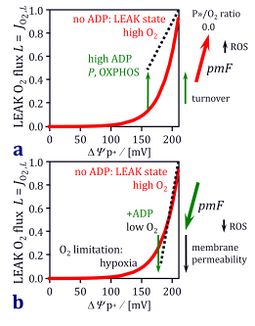Gnaiger 2001 Respir Physiol
| Has title::Gnaiger E (2001) Bioenergetics at low oxygen: dependence of respiration and phosphorylation on oxygen and adenosine diphosphate supply. Respir Physiol 128:277-97. |
» [[Has info::PMID: 11718759]], [[Has info::![]() ]]
]]
Was written by::Gnaiger E (Was published in year::2001) Was published in journal::Respir Physiol
Abstract: [[has abstract::Oxygen limitation is generally considered as impairment of mitochondrial respiration under hypoxia and ischemia. Low intracellular oxygen levels under normoxia, however, imply mild oxygen limitation, provide protection from oxidative stress, and result from economical strategies for oxygen transport through the respiratory cascade to cytochrome c oxidase. Both perspectives relate to the critical oxygen pressure which inhibits mitochondrial respiration. Based on methodological considerations of oxygen kinetics and a presentation of high-resolution respirometry, mitochondrial oxygen affinities (1/p50) are reviewed with particular emphasis on the turnover effect under control of ADP, which increases the p2 in active states. ~P/O2 flux ratios are high even under severe oxygen limitation, as demonstrated by calorespirometry. Oxygen limitation reduces the uncoupled respiration observed under control by ADP, as shown by relationships derived between ~P/O2 flux ratios, respiratory control ratios, and ADP kinetics. Bioenergetics at low oxygen versus oxidative stress must be considered in the context of limitation of maximum aerobic activity, ischemia-reperfusion injury, mitochondrial signalling to apoptosis, and mitochondrial theories of ageing.]] • Keywords: has publicationkeywords::Energy: Oxidative phosphorylation, has publicationkeywords::Adenosine diphosphate kinetics, [[has publicationkeywords::Adenosine diphosphate/O2 ratio; Hypoxia: Mitochondrial O2 kinetics]], has publicationkeywords::Mammals: Rat, has publicationkeywords::Membrane permeability, has publicationkeywords::Mitochondria: Heart, has publicationkeywords::Liver
• O2k-Network Lab: Was published by MiPNetLab::AT Innsbruck Gnaiger E
Labels: MiParea: MiP area::Respiration, MiP area::Instruments;methods, MiP area::Comparative MiP;environmental MiP
Stress:Injury and adaptation::Oxidative stress;RONS Organism: Organism::Human, Organism::Rat Tissue;cell: tissue and cell::Heart, tissue and cell::Liver, tissue and cell::Endothelial;epithelial;mesothelial cell, tissue and cell::HUVEC Preparation: Preparation::Intact cells, Preparation::Isolated mitochondria
Regulation: Topic::ADP, Topic::Coupling efficiency;uncoupling, Topic::Oxygen kinetics, Topic::Threshold;excess capacity Coupling state: Coupling states::OXPHOS
HRR: Instrument and method::Oxygraph-2k, Instrument and method::TIP2k
Fig. 10 (modified): Opposite effects of ADP limitation and oxygen limitation on mitochondrial membrane potential, and LEAK oxygen flux, JO2,L. The LEAK state is obtained when total oxygen flux equals LEAK respiration. In all other respiratory states, total oxygen flux is the sum of LEAK oxygen flux and mechanistically coupled oxygen flux. A: ADP limitation of respiration at high oxygen levels in the transition from the OXPHOS state (P, saturating ADP) or active State 3 (high ADP) to the resting LEAK state, L (compare State 4), leads to an increase of membrane potential and exponential acceleration of the proton leak (heavy line). Because LEAK oxygen flux increases while total oxygen flux is reduced, the ATP yield (ADP/O2 flux ratio) declines to zero. Turnover-dependent proton leak increases the LEAK oxygen flux in the OXPHOS state but declines towards the LEAK state (Garlid et al 1993). Mitochondrial production of reactive oxygen species (ROS) increases with membrane potential towards the LEAK state, and ROS-linked electron bypass (electron leak) contributes minimally to LEAK oxygen flux at high oxygen (Gnaiger et al 2000). On the right, the decline of ~P/O2 flux ratios is shown in the transition from OXPHOS to LEAK. B: Oxygen limitation of respiration causes a reduction of membrane potential in the transition from ADP limitation at high oxygen, to intracellular conditions of low oxygen and low ADP, to finally severe oxygen limitation under hypoxia and anoxia. Potentially synergistic with the well documented membrane potential effect on LEAK flux, are the hypothetical effects of decreasing membrane permeability and suppression of ROS production under severe hypoxia, whereas intermediary levels of hypoxia may increase ROS production (modified from Gnaiger 2001; see original publication for further references).
* Discussion: Oxygen dependence of ROS production - are permeabilized fibres a valid model?.

